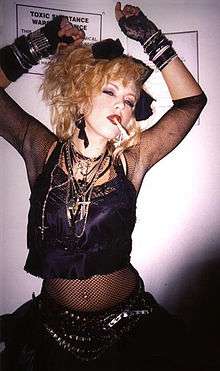Madonna wannabe

A Madonna wannabe, or Madonnabe, is a person (usually female) who dressed like pop star Madonna. The term was popularized by writer John Skow in a May 1985 Time cover story on the singer.[1] Following the disappearance of the trend, critics and journalists referred to female pop stars who emulated Madonna (with styles or musical) as Madonna wannabes.
History
The Madonna wannabe trend was at its peak from 1984 until 1986. During that time, it was common to see young women across the world dressed in the style affected by pop star Madonna in that era:[2][3][4] a thrift shop look that incorporated many beads, lace tops, bleached hair, rosaries, crucifixes, skirts, bracelets and bustiers. Sometimes the wannabes wore men's boxer shorts outside their clothes. Skow commented on the phenomenon:
"The bright side of this trend is that these Wanna Be's (as in "We wanna be like Madonna!") could be out somewhere stealing hubcaps. Instead, all of them, hundreds of thousands of young blossoms whose actual ages run from a low of about eight to a high of perhaps 25, are saving up their baby-sitting money to buy cross-shaped earrings and fluorescent rubber bracelets like Madonna's, white lace tights that they will cut off at the ankles and black tube skirts that, out of view of their parents, they will roll down several turns at the waist to expose their middles and the waistbands of the pantyhose."[1]
In 1985, Macy's department store opened "Madonnaland", a boutique selling clothes modelled after the singer's style.[5][6] The Madonna wannabe trend largely disappeared by the end of 1986 when Madonna dramatically altered her look with the release of her third album, True Blue. However, some fans of the entertainer still dress in the mid-1980s Madonna style, though usually this is only for Eighties nostalgia days and parties.
Continuity with the term
Following the disappearance of the trend, critics and public used the term to refer female pop stars who had notable similarity with or majorly influenced by Madonna. When inducting Madonna into the Rock and Roll Hall of Fame, American singer and actor Justin Timberlake stated that "The world has always been full of Madonna wannabes, and I might have even dated a couple" referring to his former girlfriend, Britney Spears.[7] William Anthony Donohue, the president of the Catholic League for Religious and Civil Rights, called Lady Gaga a mediocre "Madonna wannabe" due to the usage of Catholic imagery in her "Alejandro" music video.[8] Chris Riemenschneider, a journalist of Star Tribune, wrote an article in 2012 ranking several singers as "Madonna wannabe", including Britney Spears, Christina Aguilera, Katy Perry, Rihanna, as well as Lady Gaga who topped the list with 10 out of 10 rating.[9] In Latin America, pop artists have also received strong influence from Madonna, especially the Mexican singer Paulina Rubio, who has received an undeniable influence since her debut album and is considered "La Madonna Latina".[10]
See also
References
- 1 2 Skow, John (1985-05-27). "Madonna Rocks the Land". Time. Time Inc. p. 7. Retrieved 2008-11-07.
- ↑ Dante Craig 2001, p. 124
- ↑ Edwards & Bhaumik 2008, p. 264
- ↑ "A star with staying power | She was different". CNN. Turner Broadcasting System (Time Warner). Retrieved January 31, 2013.
- ↑ Dickinson 2003, p. 187
- ↑ "Return to Madonnaland". Boy Culture. February 22, 2010. Archived from the original on October 2, 2015. Retrieved January 31, 2013.
- ↑ "Britney Spears a Madonna wannabe". Reuters. Retrieved 15 January 2015.
- ↑ "Lady Gaga dismissed as 'Madonna wannabe' for 'Catholic bashing' music video". Retrieved 15 January 2015.
- ↑ "Lifting the Material Girl's material". Retrieved 15 January 2015.
- ↑ "Paulina Rubio dice que es un orgullo que la califiquen como la "Madonna latina"". Cooperativa.cl. Retrieved 14 October 2018.
Bibliography
Further reading
- Boisvert, Donald L.; Jay, Emerson Johnson (2012). Queer Religion, Volumen 1. ABC-CLIO. ISBN 0313353581.
- Brownlee, Nick (2003). Bubblegum: the history of plastic pop. Sanctuary. ISBN 1860745121.
- Cross, Mary (2007). Madonna: A Biography. Greenwood Publishing Group. ISBN 0-313-33811-6.
- Fouz-Hernández, Santiago; Jarman-Ivens, Freya (2004). Madonna's Drowned Worlds. Ashgate Publishing, Ltd. ISBN 0-7546-3372-1.
- Hamer, Diane; Belinda, Budge (1994). The good, the bad and the gorgeous: popular culture's romance with lesbianism. Pandora. ISBN 0044409109.
- J. Ferraro, Thomas (2005). Feeling Italian: The Art of Ethnicity in America. New York University. ISBN 0814727476.
- Olszewski, Mike (2003). Radio Daze: Stories from the Front in Cleveland's Fm Air Wars. Kent State University Press. ISBN 0873387732.
- Sardà, Joan (2008). Amy winehouse: La chica mala del pop rock (in Spanish). Ediciones Robinbook. ISBN 8496924556.
- Sellers, John (2007). Perfect from Now On: How Indie Rock Saved My Life. Simon & Schuster. ISBN 1416539123.
- Drader, Brian (2004). Breakout. Scirocco Drama. p. 116. ISBN 0920486630.
- Merrell, Floyd (2003). The Mexicans: A Sense Of Culture. Westview Press. p. 110. ISBN 0813340446.
- Brown, Stephen (2004). Free Gift Inside!!: Forget the Customer. Develop Marketease. John Wiley & Sons. ISBN 1841126020.